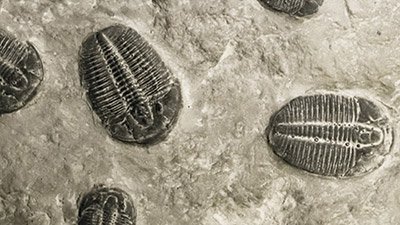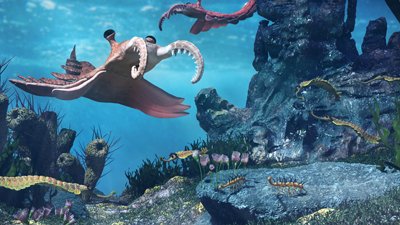
The Evolution of the Permian Extinction?
One long-standing evolutionary “tale” is that toward the end of the Permian period (conventionally dated 252–299 million years ago) 90% of marine creatures and 75% of terrestrial organisms were wiped out in the most devastating mass extinction in all of history.1 This supposed mass extinction, sometimes called “The Great Dying,” is said to have happened over the course of 15 million years (or 200,000 years, depending on which evolutionist you ask!) and is said to have decimated shallow-water marine invertebrates, which make up the bulk of Permian fossils, as well as some aquatic and terrestrial vertebrates.2 Other groups, including some reptile and amphibian species, supposedly underwent serious decline during this time as well. There are many different stories of what caused the Permian extinction, but it has generally been agreed that this supposed extinction event was devastating to land and aquatic species. However, the interpretation of new research on Permian fossils challenges this story.3
A team of geologists claim that their work with the reptile fossil Dicynodon, “whose disappearance defines the terrestrial extinction event in the rock record,”4 shows that the supposed terrestrial mass extinction happened before the marine extinction. They claim that their study challenges the idea that there even was a mass terrestrial extinction. Geologist John Geissman of the University of Texas, who was part of the study, says, “We need to rethink the Permian crisis.”5 They base much of their research on the dating of zircons which appear in the same rock layers as Dicynodon in the fossil record. Of course, in dating Dicynodon so confidently, they ignore the unprovable assumptions behind radiometric dating which make it unreliable.6 The team also noticed “traces of land plant and animal species thought to have gone extinct alongside Dicynodon in younger rocks. Those findings don’t point to a single widespread extinction event that abruptly wiped out land species within a short time span . . . [instead they] support the idea that the Permian extinction lacked a land component.”7
Same Data, Different Interpretation?
The conclusions based on this study are not being accepted by many evolutionists and will certainly continue to be researched. However, it does highlight the changing nature of evolutionary models for Earth’s history. What is today’s fact is destined for tomorrow’s trash bin. It only takes a quick Google search to see how often evolutionary models change as new fossils are uncovered or new interpretations of research are printed. This highlights the nature of historical science. Scientists try to develop models for Earth’s history based on the observational evidence (i.e. Dicynodon fossils), but this evidence needs to be interpreted and one’s starting point (man’s word or God’s Word) determines one’s conclusions. Evolutionists begin with the wrong starting point by ignoring God’s Word.
Creationists are often mocked if they change their scientific models (none of which affects the never-changing foundational truth of God’s Word, but rather just our understanding of a typically small aspect—e.g., the now disfavored canopy model), and yet evolutionists change their models and even key aspects of evolution all the time. But this shouldn’t come as a surprise since the evolutionary model is so plastic, because it’s based off man’s fallible ideas about the past, that it can accommodate virtually anything.
Can the Flood Explain the Data Better?
According to creation geologists, one model is that the geological timescale actually represents different ecological zones, the buried remains of plants and animals that once lived together in the same environment. The different rock layers of the Earth are not like a walk through the Geologic Periods (in this case the Permian and the Triassic); instead, they are like a walk from the bottom of the ocean, across the tidal flats, over the shore, across the low-lying areas, and into the uplands and pre-Flood mountain regions.
Creationists have presented other reasons as well for the order in the fossil record.8 Many concern the way moving water sorts objects of different weight, density, and buoyancy. Others compare the mobility of such creatures as marine invertebrates (not very mobile) to humans, birds, and mammals (much more mobile). The latter group would have generally been able to seek higher ground as the Flood waters rose. Taken together, all these reasons can account for the order in the fossil record. The fossil record is therefore a testimony to the rapid burial of billions of organisms by sediments in a watery cataclysm.
Do creationists expect to see huge marine die-offs at all stages of the Flood? Yes, because marine creatures lived in the oceans where the Flood began and were thus at the mercy of the Flood waters and the sediments they eroded and carried, which would suffocate them. Depending on what ecological zone they were in, we would expect to see some marine animals (typically sessile or bottom dwellers) in the lowest layers (earliest stages of the Flood) and more mobile sea creatures, like fish and aquatic mammals higher in the layers representing later stages of the Flood. Likewise, we would expect to see coastal-dwelling and less mobile terrestrial animals in the middle layers of the Flood rock record and higher-elevation and more mobile animals higher up. This doesn’t represent a millions of years’ time differential between each layer, but a few hours, days, or maybe weeks at most between advances and temporary recessions of the Flood waters.
Continuing Evolution of the Paradigm
It is almost ironic that Dicynodon was the fossil which sparked this latest proposed revision to the Permian extinction hypothesis. As stated above, uniformitarian geologists had used Dicynodon fossils to delineate the Permian-Triassic boundary, but as few as 20 years ago, this was not the case. Dicynodon was believed to have survived the Permian extinction and “made it” to the Triassic. According to Joseph Alper, “ . . . the mammal-like reptiles fared no better. Of the 50 genera of these creatures that lived during the Permian period, only one, the genus, Dicynodon made it into the Triassic.”9 So 20 years ago it was claimed that Dicynodon survived the Permian extinction, then it was used to delineate the Permian extinction, and now it apparently went extinct prior to the end of the Permian. That’s a lot of change for one genus in a 20-year period. Other terrestrial plant and animal species in this study were found above the Permian-Triassic boundary,10 making the terrestrial portion of the Permian extinction event only a partial extinction event.
How Should We Understand the Data?
A massive die-off of many marine organisms and some terrestrial ones fits well with the Flood geology paradigm. Marine organisms, and terrestrial amphibians and reptiles, would be expected to be washed together into mass graves during the middle stages of the Flood. As the Flood waters continued to rise, they would eventually sweep over various terrestrial ecological zones, with the pre-Flood uplands and the mountains being progressively covered in later stages. As a result of this inundation of those terrestrial ecological zones, we would begin to see layers deposited with fossils of creatures that were more readily able to flee the rising waters for a time. Dinosaurs, then mammals and birds, would be expected to be found in the highest layers as they were buried even later in the Flood.
God’s Unchanging Word
Evolutionary scientific models constantly change as new evidence is discovered or as old evidence is interpreted in a different fashion than before. Evolution itself is such a plastic paradigm that it is simply molded to fit the new evidence and interpretation of the data. But scientific models based on the unchanging foundation of God’s Word consistently explain the evidence without having to radically change with each new discovery. This is because God’s Word provides the true history of the universe, and God’s Word never changes. Now, of course, creationists do sometimes change their models of a particular aspect or mechanism (e.g., the now disfavored canopy model), as new evidence comes to light, but the basic framework that is derived from God’s Word never changes. We can trust that God has given us in His Word an accurate account of Earth’s history.
Footnotes
- Encyclopaedia Britannica, s.v. “Permian extinction,” http://www.britannica.com/science/Permian-extinction.
- Ibid.
- Robert A. Gastaldo et al., “Is the Vertebrate-Defined Permain-Triassic Boundary in the Karoo Basin, South Africa, the Terrestrial Expression of the End-Permian Marine Event?,” Geology 43, no. 10 (2015): 939–942, doi:10.1130/G37040.1.
- Thomas Sumner, “Land Life Spared in Permian Extinction, Geologists Say,” ScienceNews, November 5, 2015, https://www.sciencenews.org/article/land-life-spared-permian-extinction-geologists-argue.
- Ibid.
- For more information on the unreliability of radiometric dating, see Dr. Andrew Snelling’s articles, “Radiometric Dating: Back to Basics,” https://answersingenesis.org/geology/radiometric-dating/radiometric-dating-back-to-basics/, and “Radiometric Dating: Problems with the Assumptions,” https://answersingenesis.org/geology/radiometric-dating/radiometric-dating-problems-with-the-assumptions/.
- Sumner, “Land Life Spared . . . ”
- See chapter 91 (pp. 727–737) of Andrew Snelling, Earth’s Catastrophic Past: Geology, Creation and the Flood (Green Forest, AR: Master Books, 2009).
- Joseph Alper, “Earth’s Near-Death Experience,” Earth 3, no. 1 (January 1994): 44.
- Gastaldo et al., “Is the Vertebrate-Defined Permian-Triassic Boundary . . . ?,” doi:10.1130/G37040.1.
Recommended Resources

Answers in Genesis is an apologetics ministry, dedicated to helping Christians defend their faith and proclaim the good news of Jesus Christ.
- Customer Service 800.778.3390
- Available Monday–Friday | 9 AM–5 PM ET
- © 2026 Answers in Genesis





